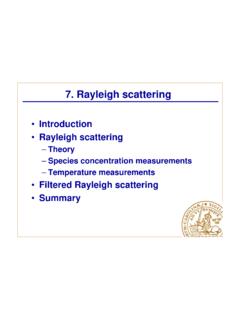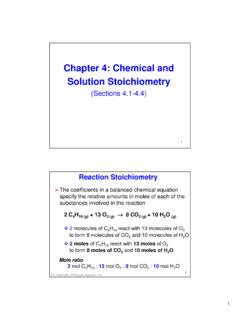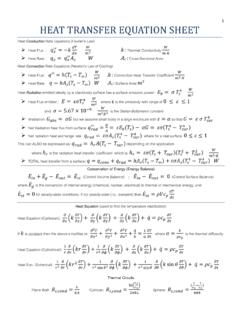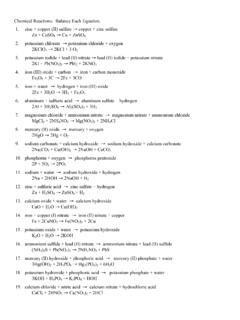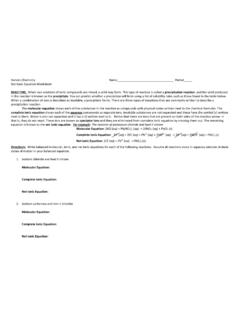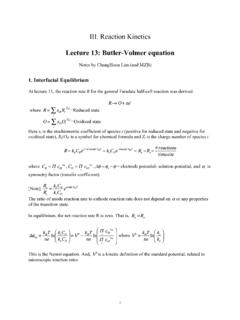Transcription of Lecture 2 Adiabatic Flame Temperature and Chemical …
1 Lecture 2 Adiabatic Flame Temperature and Chemical balance:*) The list of energies is not exhaustive, f. e. work of forces and kinetic or potential energies are missing, but the most important which will appear in a balance are considered of specific internal energy:duspecific work due to volumetric changes: wrev=pdv, v=1/ specific heat transfer from the surroundings: qspecific frictional work: wR*)Related quantitiesspecific enthalpy (general definition): specific enthalpy for an ideal gas:First law of thermodynamics- balance between different forms of energyMulticomponent systemThe specific internal energy and specific enthalpy are the mass weightedsums of the specific quantities of all speciesFor an ideal gas the partial specific enthalpy is related to the partial specific internal energy an ideal gas the inner energy and enthalpy depend on Temperature alone.
2 Ifcpiis the specific heat capacity at constant pressure and hi,refis the reference enthalpy at the reference Temperature Tref, the Temperature dependence of the partial specific enthalpy is given byThe reference Temperature may be arbitrarily chosen, most frequently used: Tref= 0 K or Tref= K partial molar enthalpy isand its Temperature dependence iswhere the molar heat capacity at constant pressure isIn a multicomponent system, the specific heat capacity at constant pressure of the mixture molar reference enthalpies at reference Temperature of species arelisted in tables. It should be noted that the reference enthalpies of H2, O2, N2and solid carbon Cswere chosen as zero, because they represent the Chemical elements. Reference enthalpies of combustion products such as CO2and H2O are typically negative. Temperature dependence of molar enthalpy, molar entropy and molar heat capacities may be calculated from the NASA constants ajfor each species iare listed in Polynomials for two Temperature ranges and standard pressure p = 1 atmFirst law of thermodynamics for an Adiabatic system at constant pressure( q= 0, dp= 0)we neglect the work done by friction ( wR= 0).
3 From we then have: Integrated from the unburnt, index u, to the burnt state, index b, it the Temperature dependence of the specific enthalpythis may be written asHere the specific heat capacities are those of the mixture, to be calculated with the mass fractions of the burnt and unburnt a one-step global reaction the left hand side of may be calculated by integratingwhich givessuch : heat of combustionThe heat of combustion changes very little with Temperature . It is often set equal to:Simplification: Tu= Trefand assume cp,bapproximately constantFor combustion in air, the contribution of nitrogen is dominant in calculating cp,b. value of cpiis somewhat larger for CO2and somewhat smaller for O2 while that for H2O is twice as large. A first approximation for the specific heat of the burnt gas forlean and stoichiometric mixtures: cp= kJ/kg/KAssuming cpconstant and Q = Qref, the Adiabatic Flame Temperature for a lean mixture(YF,b= 0) is calculated from and with F= - ' a rich mixture must be replaced byOne obtains similarly for complete consumption of the oxygen (YO2,b= 0) and may be expressed in terms of the mixture fraction.
4 Introducing and and specifying the Temperature of the unburnt mixture bywhere T2is the Temperature of the oxidizer stream and T1that of the fuel stream. This equation describes mixing of the two streams with cpassumed to be constant. and then take the formThe maximum Temperature appears at Z = mixture fractionsand stoichiometric Flame temperaturesforsome hydrocarbon-air mixtures the table for combustion of a pure fuels (YF,1= 1) in air (YO2,2= ) withTu,st= 300 K and cp= kJ/kg/KChemical EquilibriumThe assumption of complete combustionis an approximation because it disregards the possibility of dissociation of combustion products. A more general formulation is the assumption of Chemical equilibrium. Complete combustion represents the limit of an infinite equilibrium constant (see below).
5 Chemical equilibrium and complete combustion are valid in the limit of infinitely fast reaction rates only, which will seldom be valid in combustion systems. We will consider finite rate Chemical kinetics in a later Lecture . for hydrogen diffusion flames complete Chemical equilibrium is a good approximation, while for hydrocarbon diffusion flames finite kinetic rates are needed. In hydrocarbon diffusion flames the fast chemistry assumption overpredicts the formation of intermediates such as CO and H2due to the dissociation of fuel on the rich side by large amounts. Nevertheless, since the equilibrium assumption represents an exact thermodynamic limit, it shall be considered potential and the law of mass actionDifferently from the enthalpy, the partial molar entropy Siof a Chemical species in a mixture of ideal gases depends on the partial pressurewhere p0= 1 atm anddepends only on Temperature .
6 Values for the reference entropy Si,refare also listed in partial molar entropy may now be used to define the Chemical potentialwhereis the Chemical potential at 1 atm. The condition for Chemical equilibrium for the l-th reaction is given inleads toDefining the equilibrium constant Kplbyone obtains the law of mass constants for three approximation of equilibrium constants may be derived by introducing the quantityFor constant Cpithe second term in this expression would yield a logarithm of the Temperature , while the last term does not vary much if . Therefore i(T) may be approximated this intoone obtainswhere was used for iAand iBwere obtained by linear interpolation in terms of lnTfor the values given in the JANAF-Tables at T = 300 K and T = 2000 K. For some species, which are important in combustion, values for iAand iBare listed in Tab.
7 Of the Lecture of Tab. :An example: Equilibrium Calculation of the H2-air systemUsing the law of mass action one obtains for the reaction 2 H2+O2= 2 H2 Othe relation between partial pressureswherewas approximated using and the values for from the Janaf-Table. the definitionthe partial pressures are written with aswhere the mean molecular weight element mass fractions of the unburnt mixture areThese are equal to those in the equilibrium gas wherewhile ZNremains unchanged. equations lead to the following nonlinear equation for H2O, equation has one root between H2O,b= 0 and the maximum values H2O,b= ZH/2 WHand H2O,b= ZO/WOwhich correspond to complete combustion for lean and rich conditions in the limit The solution, which is a function of the Temperature , may be found by successively bracketing the solution within this Temperature is then calculated by employing a Newton iteration on leading iteration converges readily followingwhere i is the iteration index.
8 The solution is plotted here for a hydrogen-air Flame as a function of the mixture fraction for Tu= 300 table shows equilibrium mass fractions of H2, O2and H2O for p=1 bar and p=10 bar and different Temperature profiles for lean methane, acetylene and propane flames as a function of the equivalence ratio for Tu= 300 heterogeneous equilibriumA reaction is called heterogeneous, if it occurs for instance at the gas-to-solid interface. Since the Chemical potential of the solid is independent of pressureonly the partial pressures of the gaseous components will appear in the law of mass action. : the reaction of solid carbon with oxygene Cs+ O2= CO2 The ratio of partial pressures of CO2and O2becomesHere the molar enthalpy HCs, refof solid carbon is zero per definition,while A,Cs= - and B,Cs= the equilibrium mole fraction of NO in air at T = 1000 K and T = 1500 Kby assuming that the mole fractions of O2(XO2= ) and N2(XN2= ) equilibrium constant of the reaction N2+ O2= 2 NOis with the values of the Janaf the partial pressure of NO one hasNeglecting the consumption of N2and O2as a first approximation, their partial pressures in air may be approximated as The equilibrium mole fraction of NO is thenAt T= 1000 K one obtains 38 ppv (parts per volume = Xi10-6) and at T= 1500 K230 ppv.
9 Indicates that at high temperatures equilibrium NO-levels exceed by farthose that are accepted by modern emission standards which are around 100 ppv or considerations therefore suggest that in low Temperature exhaust gases NO is above the equilibrium value and can be removed by



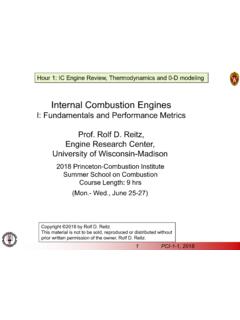
![Lecture 8 Raman [Kompatibilitetsläge]](/cache/preview/d/b/6/8/9/c/e/c/thumb-db689cecbc617a8952df49950b757eeb.jpg)
